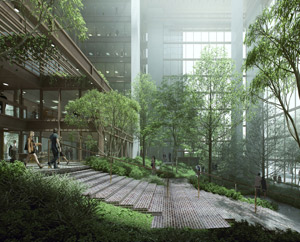11.11.24 — Back to the Garden
It was 1972, and environmentalists were desperate. At least Helen Mayer and Newton Harrison were, and they sought a “survivalist alternative” where you might never expect it, in a work of art—and I work this together with past reports on summery sculpture indoors and out in Harlem Sculpture Gardens and by Alexis Rockman and Tiril Hasselknippe as a longer and fuller review in my latest upload.
Their Survival Piece (the fifth of seven) made its debut that year in the gallery at Cal State Fullerton. In its Portable Orchard, nature had an assist from recycled redwood and artificial light. Now the Whitney recreates it,  through January 1, and one can hear their urgency. “To survive as a species,” they wrote, “we are going to have to learn how to grow our own food and take care of ourselves.” So why has it gone all but forgotten? And why does it look so calm, so composed, and so green?
through January 1, and one can hear their urgency. “To survive as a species,” they wrote, “we are going to have to learn how to grow our own food and take care of ourselves.” So why has it gone all but forgotten? And why does it look so calm, so composed, and so green?
The Harrisons were themselves survivors. Like the fruit of their “sustainable food system,” they lived to a ripe old age. They would be in their nineties were they alive today. Their indoor citrus grove includes all that one might wish, including lemons, limes, grapefruit, and naval and mandarin oranges, each carefully labeled. On the First of July, just days after the opening at the Whitney, young fruit had already begun to appear. As if to proclaim their eco-friendliness, they were all still green.
To appreciate it, though, you may have to get past the rhetoric. The enterprise sounds not just urgent, but downright bureaucratic. It speaks of not natural farming, which in any case takes more land to feed the millions, but natural farming practices—and they are not just obsolete, but “cannot be taken for granted.” You must get past the contradictions as well. This may be sustainable agriculture, but not for eating. If it makes you think of Rirkrit Tiravanija, “relational esthetics,” interactive art, free food, and sharing, forget it, and do not touch.
Perhaps the contradictions come with the territory, where fears mix with love. The Whole Earth Catalog appeared in 1972, Silent Spring was ten years old, and the Whitney has copies of both. Like the EPA, established in 1970, they attest to urgency, but also to hope. Artists may have felt a sense of desperation as well, as late modern art gave way to criticism and chaos. Besides, fears are easier to understand than ever in light of climate change. Yet artists like Maya Lin do not just conserve the environment, but transform it.
The orchard flourishes all the same. The Whitney has removed its eighth-floor partitions, leaving a wide-open room with planters in neat rows. They share their redwood hexagons with parallel light tubes directly above. As trees grow, their peaks extend into those upper hexagons as well. Other survival pieces included a hog pasture, a fishery, and an entire farm, all portable. Here a uniform design and strong colors carry the day.
It is tendentious all the same. This is not the future, sustainable or otherwise. It is art, and a true New York landmark shows what that might mean. Back from college in the 1970s, I was rediscovering the city, its neighborhoods and its architecture. The Ford Foundation on East 42nd Street offered a glorious respite from my minimum-wage job barely a block away. Like the Harrisons, it, too, took nature indoors and artifice into nature.
Finished in 1967, its twelve stories of offices surround a soaring atrium—a place for walking, sitting, and contemplation. Greenery blossoms out from the balconies and rises from the floor. A collaboration between Dan Kiley, the landscape architect (whose other landmarks include Gateway Arch National Park in St. Louis), and Kevin Roche and John Dinkeloo (who also designed the Met’s American wing), it brought a temperate environment and a seamless flow of plants, trees, pink stone, and rusted steel. It has its surfeit of good intentions, too, no doubt. It has after all, been the Ford Foundation Center for Social Justice since restoration in 2019 (and I described it at greater length then). Still, by comparison, that citrus grove is a lemon.
Read more, now in a feature-length article on this site.